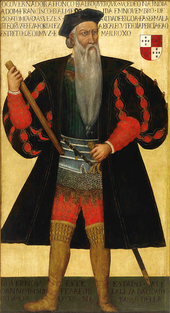Rafael Perestrello
Rafael Perestrello | |
|---|---|
| Born | 15th century |
| Died | 16th century |
| Nationality | Portuguese |
| Occupation | Explorer |
| Known for | One of the first Europeans to reach China by sea during the Age of Discovery. |
Rafael Perestrello (
João de Barros (1496–1570) wrote that Rafael Perestrello almost became lost while sailing by the Andaman Islands, but ventured safely through territory that was rumored to be inhabited by native cannibals.[4]
Family background

Filippo Perestrello (also known as Filippone Pallastrelli), Rafael's great-grandfather and son of Gabriele Palastrelli and wife Madama Bertolina, was a nobleman from the Italian city of Piacenza who moved with his wife Catarina Sforza to Portugal in 1385, living in Porto and then in Lisbon to conduct trade.[5] Filippo and Catarina had four children: Richarte (sometimes referred to as Rafael), Isabel (married to Aires Anes de Beja), Branca (who had natural issue by Dom Pedro de Noronha, 4th Archbishop of Lisbon from 1424 to 1452) and Bartolomeu (father-in-law to Christopher Columbus by his daughter Filipa).[5] Richarte Perestrello (b. 1410) became a Prior in the parish of Santa Marinha in Lisbon, yet fathered two children who he legitimized in 1423.[5] Rafael was the son of Richarte's son João Lopes.
Voyages to China
Rafael sailed in a ship from Portuguese Malacca to Guangzhou in southern China in 1516, sent by Afonso de Albuquerque, the Viceroy of Estado da India, in order to secure trading relations with the Chinese during the reign of the Ming dynasty ruler Zhengde (r. 1505–1521). Rafael traveled with a crew from a Malaysian junk,[6] bringing back profitable trade items and glowing reports about China's commercial potential.[3] In fact, his report on China was one of the main reasons why Fernão Pires de Andrade decided to carry out his mission in going to China instead of Bengal in 1517.[3][7] Rafael was admitted into port by Chinese authorities in order to trade with the merchants there, but was not allowed to move further. In 1517, Rafael piloted yet another trade mission to Guangzhou.[2]
Rafael Perestrello's mission was followed up in 1517 by the Portuguese apothecary Tomé Pires and pharmacist, merchant, and diplomat Fernão Pires de Andrade, in a diplomatic mission to Ming China commissioned by Manuel I of Portugal (1495–1521). Initial trade and diplomatic missions were temporarily ruined once wild rumors of Portuguese cannibalizing Chinese children was coupled with real events of Portuguese settlers breaking Chinese laws, pillaging Chinese villages, and taking off with female captives; the Chinese responded by burning and capturing Portuguese ships, detaining Portuguese prisoners, and executing some who were captured.[8][9] The ex-sultan Mahmud Shah of Malacca had also sent diplomatic envoys to Ming dynasty China to seek aid in expelling the Portuguese from Malacca; although this was never carried out, the sultan's mission did succeed in convincing the Ming court in rejecting the Portuguese embassy of Andrade and Pires after the death of the Zhengde Emperor in 1521.[10]
Despite these initial hostilities, a Portuguese settlement was eventually established at
A captain in Sumatra

Rafael served as a captain under Jorge de Albuquerque, the younger cousin of Afonso, when the former was governor of Malacca and battled against the
See also
- Europeans in Medieval China
- Age of Discovery
- Henry the Navigator
- History of the Ming dynasty
- History of Portugal (1415-1542)
References
Citations
Bibliography
- ISBN 0-520-22154-0(Paperback).
- Dames, Mansel Longworth. (2002) The Book of Duarte Barbosa. New Delhi: J. Jelley; Asian Educational Services. ISBN 81-206-0451-2
- Dion, Mark. "Sumatra through Portuguese Eyes: Excerpts from João de Barros' 'Decadas da Asia'," Indonesia (Volume 9; 1970): 128–162.
- Douglas, Robert Kennaway. (2006). Europe and the Far East. Adamant Media Corporation. ISBN 0-543-93972-3.
- Madariaga, Salvador de. (1940). Christopher Columbus. New York: The MacMillan Company.
- Madureira, Luis. "Tropical Sex Fantasies and the Ambassador's Other Death: The Difference in Portuguese Colonialism," Cultural Critique (Number 28; Fall of 1994): 149–173.
- Wills, John E., Jr. (1998). "Relations with Maritime Europe, 1514–1662," in The Cambridge History of China: Volume 8, The Ming Dynasty, 1368–1644, Part 2, 333–375. Edited by Denis Twitchett and Frederick W. Mote. New York: Cambridge University Press. ISBN 0-521-24333-5.
- Nowell, Charles E. "The Discovery of the Pacific: A Suggested Change of Approach," The Pacific Historical Review (Volume XVI, Number 1; February, 1947): 1–10.
- Pfoundes, C. "Notes on the History of Eastern Adventure, Exploration, and Discovery, and Foreign Intercourse with Japan," Transactions of the Royal Historical Society (Volume X; 1882): 82–92.
